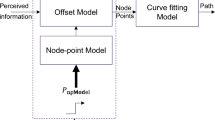Abstract
Most prior crowd simulations do not have groups of people moving in a social manner. In our work, we use a two-level steering system based on two classes: group agent and pedestrian agent. By interpolating the current and desired slot positions of the group agent according to formation templates, dynamic social group formations can be achieved and can also adapt to the width of passageways using our robust and optimized ray casting technique. Based on this interpolation approach, slot-locking keeps subgroups in a group shoulder-to-shoulder regardless of the current formation assuming sufficient surrounding space exists. At times pal social gestures between adjacent members may occur. We also introduce the social FIFO queue to be used in situations such as waiting for the bus. In the subway scene, we describe a seating strategy for passengers entering the subway car and being aware of your presence. In an immersive evaluation using an Oculus DK2 head-mounted display, participants validated the realism of dynamic social group behavior for navigation and making use of public transportation.
















Similar content being viewed by others
References
James, J.: The distribution of free-forming small group size. Am. Sociol. Rev. 18, 569–570 (1953). doi:10.2307/2087444
Coleman, J.S., James, J.: The equilibrium size distribution of freely-forming groups. Sociometry 24(1), 36–45 (1961)
Pelechano, N., Allbeck, J., Badler, N.: Virtual Crowds: Methods, Simulation, and Control. Morgan and Claypool Publishers, San Rafael (2008)
Thalmann, D., Musse, S.: Crowd Simulation, 2nd edn. Springer, London (2012)
Musse, S.R., Thalmann, D.: A hierarchical model for real time simulation of virtual human crowds. IEEE Trans. Vis. Computer Graph. 22(2), 152–164 (2001). doi:10.1109/2945.928167
Musse, S.R.: Human crowd modeling with various levels of behaviour control. PhD thesis, EPFL, Lausanne, Switzerland (2000)
Loscos, C., Marchal, D., Meyer, A.: Intuitive crowd behaviour in dense urban environments using local laws. In: Proceedings of Theory and Practice of Computer Graphics (TPCG 2003), pp. 122–129. (2003)
Qiu, F., Hu, X.: Modeling group structures in pedestrian crowd simulation. Simul. Model. Practice Theory 18(2), 190–205 (2010). doi:10.1016/j.simpat.2009.10.005
Niederberger, C., Gross, M.: Hierarchical and heterogeneous reactive agents for real-time applications. Computer Graph. Forum 22(3), 323–331 (2003). doi:10.1111/1467-8659.00679
Hostetler, T., Kearney, J.: Strolling down the avenue with a few close friends. In: Proceedings of Eurographics Ireland Workshop, pp. 7–14 (2002)
Peters, C., Ennis, C.: Modeling groups of plausible virtual pedestrians. IEEE Computer Graph. Appl. 29(4), 54–63 (2009). doi:10.1109/MCG.2009.69
Moussaïd, M., Perozo, N., Garnier, S., Helbing, D., Theraulaz, G.: The walking behavior of pedestrian social groups and its impact on crowd dynamics. PloS One, 5(4) (2010). doi:10.1371/journal.pone.0010047
Federici, M., Gorrini, A., Manenti, L., Vizzari, G.: Data collection for modeling and simulation: case study at the University of Milan-Bicocca. Lecture Notes in Computer Science, vol. 7495, pp. 699–708 (2012)
Hocevar, R., Marson, F., Cassol, V., Braun, H., Bidarra, R., Musse, S.R.: From their environment to their behavior: a procedural approach to model groups of virtual agents. In: Proceedings of Intelligent Virtual Agents (IVA 2012), pp. 370–376. Springer, Berlin Heidelberg (2012)
Karamouzas, I., Overmars, M.H.: Simulating and evaluating the local behavior of small pedestrian groups. IEEE Trans. Vis. Computer Graph. 18(3), 394–406 (2012). doi:10.1109/TVCG.2011.133
Rojas, F.A., Yang, H.S.: Immersive Human-in-the-Loop HMD evaluation of dynamic group behavior in a pedestrian crowd simulation that uses group agent-based steering. In: Proceedings of Virtual Reality Continuum and Its Applications in Industry (VRCAI 2013), pp. 31–40. (2013). doi:10.1145/2534329.2534336
Pedica, C., Vilhjálmsson, H.H.: Spontaneous avatar behavior for human territorality. Appl. Artif. Intell. 24(6), 575–593 (2010). doi:10.1080/08839514.2010.492165
Pedica, C., Vilhjálmsson, H.H., Lárusdóttir, M.: Avatars in conversation: the importance of simulating territorial behavior. In: Proceedings of Intelligent Virtual Agents (IVA 2010), Lecture Notes in Computer Science, vol. 6356, pp. 336–342 (2010). doi:10.1007/978-3-642-15892-6_35
Pedica, C., Vilhjálmsson, H.H.: Social perception and steering for online avatars. In: Proceedings of Intelligent Virtual Agents (IVA 2008), Lecture Notes in Computer Science, vol. 5208, pp. 104–116 (2008)
Scheflen, A.E.: Human Territories: How We Behave in Space and Time. Prentice-Hall, New York (1976)
Kendon, A.: Conducting Interaction: Patterns of Behavior in Focused Encounters. Cambridge University Press, Cambridge (1990)
Ennis, C., O’Sullivan, C.: Perceptually plausible formations for virtual conversers. Computer Anim. Virtual Worlds 23(3–4), 321–329 (2012). doi:10.1002/cav.1453
Kamphuis, A., Overmars, M.H.: Finding paths for coherent groups using clearance. In: Proceedings of Symposium on Computer Animation (SCA 2004), ACM SIGGRAPH / Eurographics, 2004, pp. 19–28 (2004)
Hsu, D., Kindel, R., Latombe, J.-C., Rock, S.: Randomized kinodynamic motion planning with moving obstacles. Int. J. Robot. Res. 21(3), 233–255 (2002). doi:10.1177/027836402320556421
LaValle, S., Kuffner, J.: Randomized kinodynamic planning. Int. J. Robot. Res. 20(5), 378–400 (2001). doi:10.1177/02783640122067453
Kavraki, L., Svestka, P., Latombe, J.-C., Overmars, M.H.: Probabilistic roadmaps for path planning in high-dimensional configuration spaces. IEEE Trans. Robot. Autom. 12(4), 566–580 (1996). doi:10.1109/70.508439
Rojas, F.A., Park, J.H., Yang, H.S.: Group agent-based steering for the realistic corner turning and group movement of pedestrians in a crowd simulation. In: Proceedings of Computer Animation and Social Agents (CASA 2013) (2013)
Knabe, T.: Tore Knabe’s Blog. http://tore-knabe.com/virtual-reality#SubwayCar (2014). Accessed 28 Feb 2015
Acknowledgments
This crowd simulation is integrated into the city and subway scenes of PsyTech’s PHOBOS\({}^{\textregistered }\), a virtual reality platform being developed for the treatment of a wide range of phobias and anxiety disorders. It is funded by the IT R&D program of MSIP/KEIT [14-811-12-002].
Author information
Authors and Affiliations
Corresponding author
Rights and permissions
About this article
Cite this article
Rojas, F., Tarnogol, F. & Yang, H.S. Dynamic social formations of pedestrian groups navigating and using public transportation in a virtual city. Vis Comput 32, 335–345 (2016). https://doi.org/10.1007/s00371-015-1187-7
Published:
Issue Date:
DOI: https://doi.org/10.1007/s00371-015-1187-7




